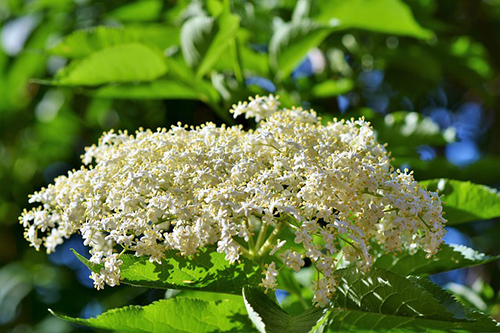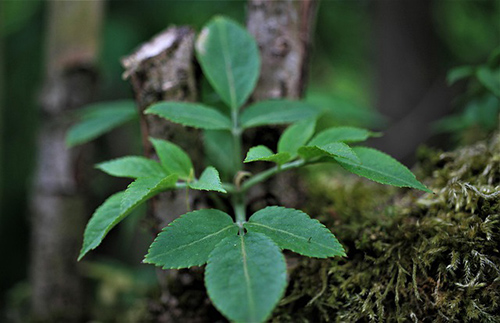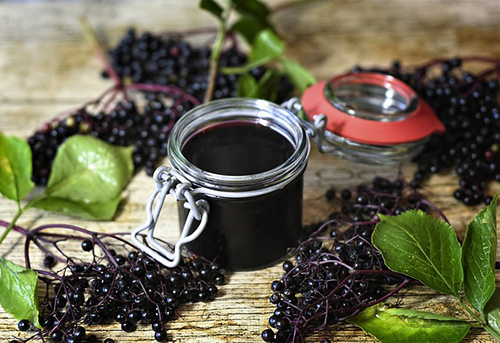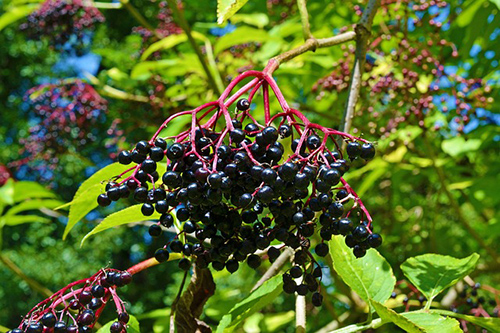Contents
The berries of the black elder plant have been food for humans since ancient times, even though the smell of its leaves can be unpleasant. The black elder is worthy of being distinguished from another similar species, the dwarf elder (Sambucus ebulus L.) whose flowers and leaves have the same properties as the black elder but whose fruits are poisonous. Here are some details that can help distinguish both species:
- The black elder is a shrub with a woody trunk and branches, while the dwarf elder is a herbaceous (like an herb) plant.
- Black elders have five or seven folioles per leaf, while dwarf elders have eleven or more.
- The fruits of the black elder hang down when ripe, while those of the dwarf elder keep upright.
- The smell of black elder is not as solid and unpleasant as that of dwarf elder.
Bear in mind this advice: we can eat the berries of the black elder with no risk of mistaking them for the dwarf elder. However, we do not recommend eating too many.

Black Elder Plant Scientific Facts
- Other names: European elder, elder.
- French: Sureau noir.
- Spanish: Sauco.
- Environment: It is common along roadsides, riverbanks, and woods all over Europe and in warm and cold areas of the American continent.
- Description: This shrub of the Caprifoliaceae family grows from two to four meters high. It has deciduous, large leaves comprising five to seven lanceolated folioles with toothed edges. The flowers are whitish and grow in umbels. The fruits are small black or violet berries.
- Parts of the plant used medicinally: The flowers, the fruits, and the inner bark of the trunk and branches.
Healing Properties and Warning
The flowers, which are part of black elder most often used in phytotherapy, contain mineral salts (especially potassium and quercetin) and organic acids, which give them sudorific, diuretic, depurative, and anti-inflammatory properties. Due to their mucilage content, they also have a mild laxative action.
The flowers of the black elder are one of the most effective sudorific and depurative substances known and are recommended in any feverish state, especially the following ones.

- Catarrh, colds, and influenza provoke abundant perspiration and depurative action, reducing congestion and easing coughs.
- Children’s rash diseases: For measles, chickenpox, and scarlet fever, with the sweat provoked by the black elder, waste substances (toxins) are eliminated, and fever decreases.
- Throat disorders: As rinses and gargles, the infusion of black elder flowers is recommended for pharyngitis, stomatitis, and tonsilitis.
- Skin disorders: For furuncles, eczema, acne, and other dermatosis, compresses and baths with an infusion of black elder leaves render good results.
- Conjunctivitis: Apply compresses on the eyes and/or eye baths with the infusion of black elder plant flowers.
The leaves of the black elder plant have similar properties to those of the flowers, though their infusion is less pleasant due to their pungent smell.
The liber, that is, the inner bark of the trunk and branches, has purgative and diuretic properties. It has been used since ancient times for edema (retention of fluids), dropsy (retention of fluids in the whole body), and ascites (accumulation of fluids in the abdominal cavity).
The berries of the black elder plant contain organic acids, sugar, vitamin C, and a cyanogenic glycoside (sambunigrin), whose toxicity is uncertain, but when taken in moderate amounts, is harmless. Due to their composition, they have stimulating and laxative properties.
In proper doses, the root (the inner bark) and the bark of young branches are diuretic and purgative. In more significant amounts, they are strongly purgative, can cause inflammation in the gastrointestinal tract, and are emetic. The elderflowers, when taken warm, can induce sweating. They are excellent in the beginning stages of the cold and flu. To make tea, combine equal parts of elderflowers with peppermint (one ounce per pint of water) and drink it as hot as possible. Drink the tea just before taking a hot bath or in bed, allowing you to sweat out the cold or the flu.
In the case of lumbago, sciatica, or neuralgia, you can follow a juice cure regimen. Take around two tablespoons of warm or cold juice two times daily until you obtain the expected results. The plant is also used in ointments to treat wounds, sprains, hemorrhoids, severe and minor skin ailments, rashes, and burns.
Note: Do not mistake the “elder” described here, the black elder, with the other three “elders” frequently used by many herbalists as “elders,” which are elder (Sambucus Canadensis), elder (Sambucus ebulus), and elder (Sambucus racemose)—all of which are different plants that are not used as much and each contains other properties.
Avoid the plant’s stems because they contain cyanide and are incredibly toxic. The North American black elder flowers appear safe, but other parts will cause a toxic reaction. Please do not use any portion of the plant during pregnancy. Every aspect of the fresh plant can cause poisoning. The fresh juice will cause diarrhea and vomiting. Unfortunately, children have suffered accidental poisoning by sucking or chewing on the bark. The cooked berries are safe and primarily used to prepare jams and pies.
Warning: Black elder is described here because many herbalists use it. However, it can be toxic and complex, so some herbalists recommend against using it as an internal remedy for ailments. Other warnings about this herb are as follows: Only use the root and bark grown in Europe. The North American root and bark contain significant amounts of a nauseating alkaloid found in fresh paint and hydrocyanic acid.

Black Elder Rob
It is prepared with one part of black elderberry juice and two parts of honey. Boil the mixture until it achieves a syrup-like consistency. Drink from three to six spoonfuls of this delicious syrup.
How to use Black Elder
- The fruit can be eaten fresh or as an extract known as black elder rob.
- Compresses soaked in a concentrated infusion of flowers (50-60g per liter).
- Cleansing of the affected skin area or the eyes with the concentrated infusion.
- Mouth rinses and gargles with the infusion mentioned above.
Infusion (flowers): Steep for fifteen minutes and take six ounces three times daily. Decoction (bark, berries, root): Simmer for fifteen minutes and take one cup at a time. Tincture (flowers): Take fifteen to thirty drops three times daily. Fluid Extract (flowers): Take ½ to one teaspoon thrice daily. Powder (bark): Take five to ten #0 capsules (30 to 60 grains) thrice daily. Powder (leaves): 10 #0 capsules (30 to 60 grains) thrice daily.
DISCLAIMER: All content on this website is presented solely for educational and informational objectives. Do not rely on the information provided as a replacement for advice, diagnosis, or treatment from a qualified medical expert. If you are pregnant, nursing, or have any preexisting medical concerns, talk to your doctor before using any herbal or natural medicines.
REFERENCES
- George D. Pamplona-Roger, M.D. “Encyclopedia of Medicinal Plants.” George D. Pamplona-Roger, M.D. Encyclopedia of Medicinal Plants. Ed. Francesc X. Gelabert. vols. 2 San Fernando de Henares: Editorial Safeliz, 2000. 767, 768. Print. [black elder plant]
- Vance Ferrell Harold M. Cherne, M.D. The Natural Remedies Encyclopedia [Book]. – Altamont, TN: Harvestime Books, 2010. – Vol. Seventh Edition: 7: pp. 142, 143.
- Mayo Clinic: https://connect.mayoclinic.org/discussion/no-black-elderberry-for-autoimmune-condition/
- National Center for Complementary and Integrative Health: https://pubmed.ncbi.nlm.nih.gov/30670267/

